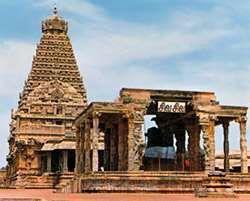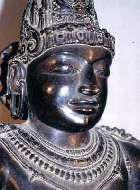South India and the Cholas Chapter Notes | History Class 9 ICSE PDF Download
| Table of contents |

|
| The Cholas - Sources |

|
| The Reign of the Chola Kings |

|
| The Chola Administration |

|
| The Chola Art |

|
Dive into the vibrant world of medieval South India, where the Chola dynasty rose to prominence, leaving an indelible mark on history with their grand temples, powerful navy, and rich Tamil literature. Emerging as the dominant force among the ancient Dravidian kingdoms of the Cheras, Pandyas, and Cholas, the Cholas transformed South India into a cultural and economic powerhouse from the 10th century AD. From the awe-inspiring Brihadeshwara Temple to the epic naval expeditions across Southeast Asia, their legacy is a testament to their ambition and artistry. These notes will take you through the Cholas’ reign, administration, and cultural contributions, unveiling the splendor of their era.
The Cholas - Sources
- South India, mainly inhabited by Dravidians, was ruled by three ancient kingdoms: Cheras, Pandyas, and Cholas.
- Cholas became the most powerful among them.
- Chera kingdom, one of the earliest, was defeated by the Pallavas in the 4th century AD.
- Cholas rose to power in the 10th century AD.
Literary Sources
- Classical Tamil literature flourished during the Chola period.
- Kuttan, court poet of Vikrama Chola, Kulottunga II, and Rajaraja II, wrote about Vikrama Chola’s wars.
- Pulgalendi, Kuttan’s contemporary, wrote Nalavenba.
- Sekkilar composed Periya Puranam, a famous poem, during Kulottunga II’s reign.
- Kalingattuparani, by Jayankondar, court poet of Kulottunga I, celebrates Kulottunga’s victory over the Kalinga king.
- Kalingattuparani details the king’s lineage, birth, family, and throne accession, considered a Tamil literature masterpiece.
Archaeological Sources
- Include inscriptions and monuments.
- Inscriptions, found on copper plates, stone, and walls, provide information about the Chola period.
- Copper plate inscriptions detail:
- Chola dynasty origins.
- Land grants to Brahmins and temples.
- Temple construction.
- Royal orders on public matters like land revenue, theft, and murder judgments.
- Copper plates highlight Chola administration and endowments.
- Monuments, mainly temples, sculptured halls, and towers, reflect Chola art, architecture, religious beliefs, and socioeconomic conditions.
- Notable temples: Brihadeshwara and Gangaikonda Cholapuram in Thanjavur, Koranganatha in Trichinopoly.
- Brihadeshwara (Rajarajeshwara) Temple, built by Rajaraja Chola in the 10th century AD, features a 13-storey tower (190 feet) and a 8.87-meter-high Shiva lingam carved from monolithic rock.
- Brihadeshwara Temple, a UNESCO World Heritage Site, exemplifies Tamil architecture.
Example: A copper plate inscription might record a Chola king granting land to a temple, specifying the village’s revenue to support priests, showing how temples were central to Chola administration and economy.
The Reign of the Chola Kings
- Vijayalaya Chola established Chola rule in AD 846, making Thanjavur the capital.
- Parantaka I, Vijayalaya’s grandson, annexed Madurai, defeating the Pandyas and Lanka rulers.
- Rajaraja I, a great Chola king, attacked the Pandyas and Cheras, annexing parts of Mysore, Travancore, and Coorg.
- Recognizing sea trade’s importance, Rajaraja led naval expeditions against Sri Lanka and Maldives but could not control them.
- Conquered northwest Ganga regions, making the Cholas a great power.
- Built the Rajarajeshwara (Brihadeshwara) Temple dedicated to Lord Shiva in Thanjavur.
- Rajendra Chola, Rajaraja’s son, ruled from AD 1012 to AD 1044, continuing expansion.
- Defeated Bengal’s king Mahipala, adopting the title Gangaikonda and building the capital Gangaikonda Cholapuram.
- Led a campaign in Southeast Asia to protect Indian merchants trading through the Malacca Straits, controlled by Shrivijaya (modern Indonesia).

- Defeated Shrivijaya’s king after Indian merchants faced issues, ensuring safe trade routes.
- Built beautiful temples in Gangaikonda Cholapuram.
- Rajdhiraj Chola, the last great ruler, died in AD 1052 during the Battle of Koppam against the Chalukyas.
- After Rajdhiraj’s death, the Chola kingdom began to disintegrate.
- Independent kingdoms of Pandyas, Cheras, and Hoysalas emerged post-disintegration.
- Chola kingdom fully collapsed after Malik Kafur, Alauddin Khilji’s general, invaded South India.
The Chola Administration
Highly organized administrative system.
King ruled with a council of ministers, touring the country to monitor administration. Royal princes managed various administrative units, handling peace and war activities. Central government promoted peace, order, prosperity, and cultural progress.
Empire divided into mandalams (provinces), further split into valanadu and nadu. Royal family princes served as provincial governors.
Cholas emphasized local self-government, with villagers managing administration in many areas. Three village assemblies: ur (landowners’ assembly), sabha (Brahmin landowners’ assembly), and nagaram (merchants’ assembly in cities). Landowning villagers elected council members through voting. Council handled tax collection, dispute resolution, and water resource allocation.
Example: In a village with an ur assembly, landowners might vote to elect a council to decide how to distribute water from a local canal, ensuring fair irrigation for all farms.
- Main revenue came from taxes on land, produce, and trade.
- Part of revenue reserved for the king; rest used for public works like dams and roads.
- Village council officials collected land taxes.
The Chola Art
- Cholas built temples, canals, roads, cities, and palaces, mostly in Dravidian style.
- Early structures were simple; later temples were grand and magnificent.
- Temple gateway called gopuram; main shrine called garbhagriha, housing deity images.
- Massive towers (vimanas) were key features of Chola architecture.
- Brihadeshwara Temple in Thanjavur is a prime example.
- Gangaikonda Cholapuram temples are magnificent architectural examples.
- Cholas excelled in crafting deity images, especially in bronze.
- Bronze image of Lord Shiva as Nataraja (Lord of Dance) is a masterpiece, representing the cultural peak of the Chola Period.

Temples were central to social life, serving as worship and community gathering places. Wealthy people donated to temples. Some temples owned land, engaged in trade, or received village land revenues instead of land grants. Temples were major employers after the state, hiring many people. Temple authorities provided education, healthcare, and met people’s needs.
Temples were educational centers, not just places of worship. Priests taught children in Tamil and Sanskrit. Vedas were taught in Sanskrit; local works in Tamil.
Chola period, known as the ‘Golden Age of Tamil Literature,’ saw significant Tamil literary growth. Kamban, an 11th century writer, composed the Tamil Ramayana. Many writers drew stories from Ramayana and Mahabharata. Pugalandi wrote Nala Venba, a love story of Nala and Damyanti. In the 12th century, Tamil works were compiled into 11 volumes called Tirumurais, considered sacred. Kalingattuparani by Jayankondar describes Kulottunga’s second war against Sri Lanka. Buddhamitra and Rawankashi wrote grammar treatises. Jain poet Amrit Sagar wrote several books, enriching Tamil literature.
- Began declining by the end of the 13th century AD.
- Continuous wars with neighboring kingdoms weakened the Cholas.
- Internal conflicts further diminished the kingdom’s strength.
|
14 videos|59 docs|16 tests
|
FAQs on South India and the Cholas Chapter Notes - History Class 9 ICSE
| 1. What were the major achievements of the Chola dynasty during their reign? |  |
| 2. How was the Chola administration structured? |  |
| 3. What role did art and architecture play during the Chola period? |  |
| 4. What were the sources of information about the Chola dynasty? |  |
| 5. How did the Chola dynasty influence trade and commerce in South India? |  |















